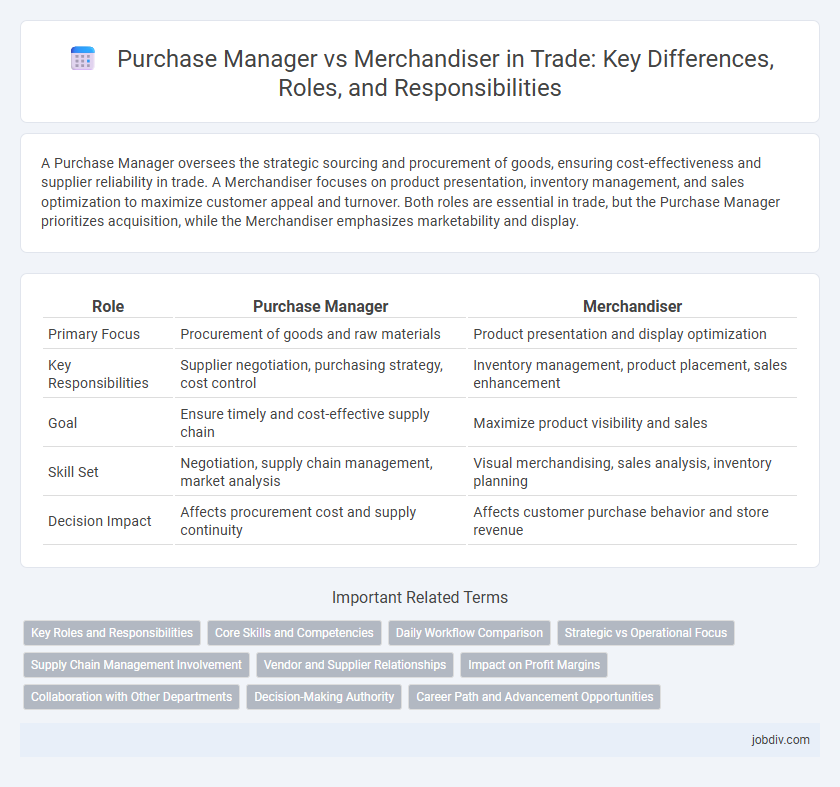A Purchase Manager oversees the strategic sourcing and procurement of goods, ensuring cost-effectiveness and supplier reliability in trade. A Merchandiser focuses on product presentation, inventory management, and sales optimization to maximize customer appeal and turnover. Both roles are essential in trade, but the Purchase Manager prioritizes acquisition, while the Merchandiser emphasizes marketability and display.
Table of Comparison
| Role | Purchase Manager | Merchandiser |
|---|---|---|
| Primary Focus | Procurement of goods and raw materials | Product presentation and display optimization |
| Key Responsibilities | Supplier negotiation, purchasing strategy, cost control | Inventory management, product placement, sales enhancement |
| Goal | Ensure timely and cost-effective supply chain | Maximize product visibility and sales |
| Skill Set | Negotiation, supply chain management, market analysis | Visual merchandising, sales analysis, inventory planning |
| Decision Impact | Affects procurement cost and supply continuity | Affects customer purchase behavior and store revenue |
Key Roles and Responsibilities
Purchase Managers oversee procurement strategies, supplier negotiations, and inventory management to ensure cost-effective acquisition of goods. Merchandisers analyze market trends, plan product assortments, and coordinate displays to maximize sales and customer satisfaction. Both roles collaborate closely to align purchasing decisions with merchandising goals, optimizing supply chain efficiency and retail performance.
Core Skills and Competencies
A Purchase Manager excels in strategic sourcing, supplier negotiation, and cost management to optimize procurement efficiency, emphasizing demand forecasting and inventory control. In contrast, a Merchandiser focuses on product selection, market trend analysis, and visual presentation to maximize sales and customer satisfaction. Both roles require strong analytical skills and market knowledge but differ in their core competencies related to supply chain management versus consumer engagement.
Daily Workflow Comparison
Purchase managers oversee supplier negotiations, order placements, and inventory management to ensure timely procurement of goods, while merchandisers focus on product assortment, display strategies, and sales data analysis to optimize in-store presentation. Purchase managers coordinate with vendors and track delivery schedules, ensuring stock availability aligns with demand forecasts. Merchandisers analyze consumer trends and sales performance daily to adjust product placements and promotional activities, enhancing customer engagement and profitability.
Strategic vs Operational Focus
A Purchase Manager primarily drives strategic procurement decisions, focusing on supplier relationships, cost optimization, and long-term supply chain planning. In contrast, a Merchandiser emphasizes operational tasks such as inventory management, product placement, and sales analysis to maximize in-store performance. Both roles are essential, with the Purchase Manager aligning sourcing strategies to business goals and the Merchandiser ensuring effective execution at the retail level.
Supply Chain Management Involvement
Purchase Managers primarily focus on sourcing and procuring raw materials or finished goods, ensuring cost efficiency and supplier reliability within supply chain management. Merchandisers concentrate on product assortment, inventory levels, and market demand to optimize stock availability and sales performance. Both roles collaborate to maintain seamless supply chain operations but differ in their strategic emphasis on procurement versus product presentation and customer alignment.
Vendor and Supplier Relationships
Purchase Managers primarily focus on building long-term strategic relationships with vendors to secure favorable terms, consistent supply, and cost efficiency, ensuring procurement aligns with organizational goals. Merchandisers work closely with suppliers to optimize product assortment, pricing, and inventory turnover, aiming to enhance sales and meet consumer demand. While both roles involve vendor interactions, Purchase Managers emphasize contract negotiation and supplier evaluation, whereas Merchandisers prioritize market trends and product presentation.
Impact on Profit Margins
Purchase managers directly influence profit margins by negotiating supplier contracts and securing cost-effective procurement, thereby reducing overall expenses. Merchandisers drive profit margins by strategically selecting and positioning products to maximize sales revenue and minimize inventory markdowns. Both roles collaboratively enhance profit margins through cost control and optimized product assortments.
Collaboration with Other Departments
Purchase Managers collaborate closely with finance and production departments to ensure budget adherence and timely procurement. Merchandisers work alongside marketing and sales teams to align product assortment with customer demand and promotional strategies. Both roles require effective communication with supply chain and warehouse units to optimize inventory levels and delivery schedules.
Decision-Making Authority
Purchase Managers typically possess higher decision-making authority, overseeing procurement strategies, supplier selection, and contract negotiations to align with corporate objectives. Merchandisers focus on product assortment, pricing, and promotion decisions, influencing sales and inventory levels but usually operate under the purchase manager's strategic framework. The distinction emphasizes Purchase Managers' broader control over sourcing and budget approval, while Merchandisers manage market-level execution and customer preferences.
Career Path and Advancement Opportunities
Purchase Managers typically progress to senior procurement or supply chain director roles by leveraging strategic sourcing and vendor management expertise. Merchandisers often advance to roles such as category managers or retail buyers, capitalizing on market trend analysis and inventory optimization skills. Both career paths offer growth through specialization, with Purchase Managers focusing on operational efficiency and Merchandisers on product assortment and consumer demand forecasting.
Purchase Manager vs Merchandiser Infographic

 jobdiv.com
jobdiv.com